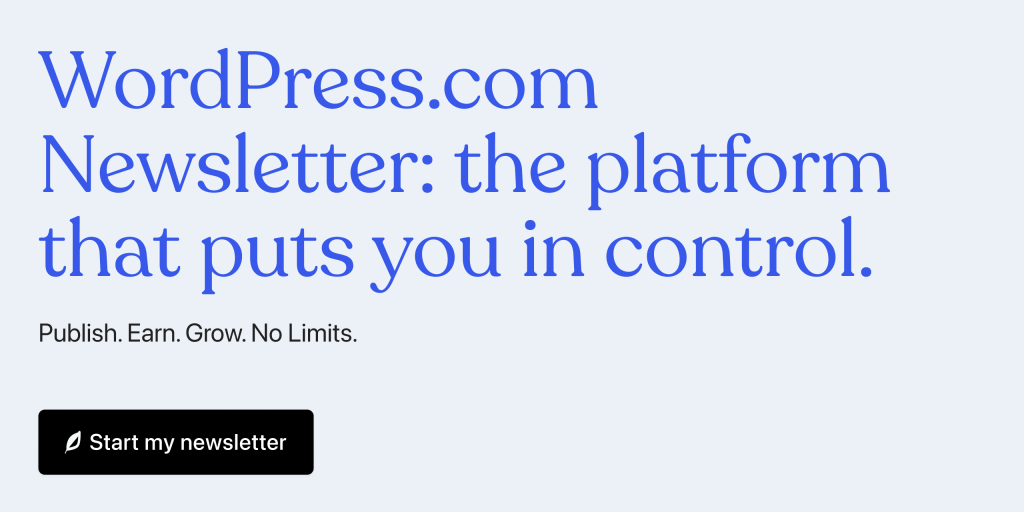
What makes someone sign-up for a newsletter?
The straightforward answer is, people sign up when you offer them something valuable in exchange for their email.
On the surface, that sounds pretty simple. But as you probably know, getting email subscribers is easier said than done. We asked successful newsletter owners about their experiences and even they share stories of struggles in the beginning.
But they also talked about their turning points with list growth, and that’s what this article is about.
If it feels like newsletter signups are trickling in at a snail’s pace, adopt these 12 tactics.
- 1. Make sure your email signup is easy to find
- 2. Tell readers exactly what they’ll get on your email signup page
- 3. Improve your call to action
- 4. Write a compelling header for your double-opt-in email
- 5. Test using content upgrades and lead magnets
- 6. Add pop-ups to your site
- 7. Promote your newsletter on social media
- 8. Consistently publish quality content that readers value
- 9. Leave a note at the end of each newsletter asking readers to share it with their friends
- 10. Cross-promote your newsletter with other newsletter authors
- 11. Guest on podcasts where you can promote your newsletter
- 12. Consider leveraging paid advertising
1. Make sure your email signup is easy to find
People can only signup for your email list when they see your call to action. So if it’s buried somewhere in your website footer, you’re likely losing a ton of potential subscribers.
Remotive runs a 73,000-subscriber newsletter where they send out job opportunities daily. They had run the newsletter for a few years, but the turning point came around August last year when signups more than tripled.

Founder, Rodolphe, says one of the things they did to capture more emails was adding more opportunities to sign up to the website.
“We multiplied Call To Action throughout our website, making the ability to subscribe way more visible,” Rodolphe says.

Consider adding a signup form or call to action in a sticky sidebar, in content, and maybe even at the top of your website.
Tip! You don’t need any complicated coding to implement a sticky sidebar. Just install a sticky sidebar plugin and add your sign-up form code to it.

2. Tell readers exactly what they’ll get on your email signup page
An unclear signup page doesn’t convey the value of your newsletter to the reader. As such, they may not sign up.
That was what Ben Goodey, Founder of SEO Case Studies’ experienced when he started his first newsletter, How the F*ck.
It took him years to get to 2,000 email subscribers, but after redesigning his homepage, he started gaining 500 – 1,000 new subscribers per month.
Ben says, “My website visitor-to-subscriber conversion rate dramatically increased when I worked on the homepage design and developed an immediate offer.”
The old landing page had a great title, but the page wasn’t clear about what people would get or the value of the case studies.
Ben took the landing page from looking like this:

To this:

Now the reward is apparent and immediate. Further down the page, Ben includes social proof in the form of testimonials too.
“Not only does it look and feel more high quality but I changed the offer from ‘Subscribe to a Weekly email’ to ’Get instant access to my library of SEO carousels,” says Ben.
3. Improve your call to action
If you’re still using a simple ‘Subscribe’ as your call to action, it’s time to change that.
One of the other things that Rodolphe from Remotive changed to grow their newsletter was the call to action.
Before, Remotive had a plain call to action that didn’t feel compelling enough to inspire action. It wasn’t clear that subscribers will receive new job opportunities, and there was nothing to differentiate the newsletter from the hundreds of other job newsletters.
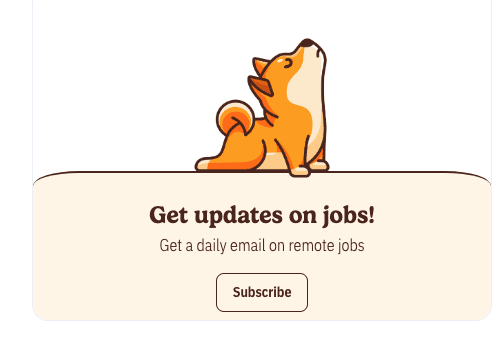
In the improved version, we see the differentiator ‘best’ remote jobs. The copy is more actionable, and the ‘free’ in the signup button hints at the reader getting something that should be paid for free.
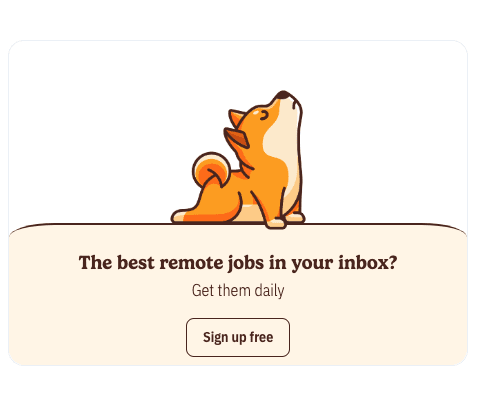
4. Write a compelling header for your double-opt-in email
When you send confirmation emails to new signups, it helps improve the delivery rate for future emails. If someone signs up to your list using a burner email that they’ll never open, you won’t have to worry about your open rates or delivery rates because they’ll never get a newsletter from you.
But the downside to it is that many people who genuinely want to hear from you will either forget to confirm their emails, or just not want to go through that extra step.
In fact, Andrea Bosoni, Founder of Zero to Marketing found that more than 40% of new signups never confirmed their subscription.
“I have double opt-in turned on to protect my list deliverability from bot and fake emails. But when I analyzed my funnel I realized that my biggest problem wasn’t driving more traffic or improving my landing page conversion rate – it was making sure that people confirmed their email address,” says Andrea.
Andrea’s newsletter recently passed 10k subscribers. He says his growth accelerated by 30% after he changed the double-opt-in email header.

“I started testing different variations of the confirmation email but nothing seemed to work. Until one day, I realized the problem wasn’t the copy but the fact that people weren’t opening the email in the first place,” Andrea continues.
He finally added “Action required” to the subject line, instead of just the “Confirm your subscription” line he used before and pending subscribers decreased by 30% overnight.
WordPress.com handles the double-opt-in process for you. No need to turn it on, so all you need to focus on is making sure subscribers understand they need to take action. Andrea’s tip to add “Action required” to the subject line is a great place to start.
5. Test using content upgrades and lead magnets
A simple ‘sign up for our newsletter’ form is better than nothing, but if you want to supercharge your list growth, offer unique lead magnets to incentivize sign-up.
Lee Moskowitz from SetSail shares how they did this.
SetSail had low brand recognition so they followed social media conversations that their audience had and discovered that people needed a report about career paths, salaries, and proving value at work.
So they created a guide to fill that gap!
Their guide ranks number 2 for the target keyword today and brings in a steady stream of highly-qualified subscribers.
You can create:
- Guides
- Checklists, cheatsheets, and templates
- Quizzes
- On-demand webinars
- And even free courses. Here’s an example of a high-performing lead magnet from Uscreen customer, Sarah Beth Yoga.

A good lead magnet will:
- Offer something unique.
- Use a presentable design and clear-benefit driven headline.
- Focus on only one topic.
6. Add pop-ups to your site
If you have a site-owned newsletter, pop-ups make sure that your readers see your sign-up form.

When I grew a 4,000 subscriber list for my blog findingbalance.mom, I had several inline forms and later added an exit-intent pop-up form.
In the same timeframe that my inline forms added 300 subscribers, my pop-up form added 2,500+ subscribers. That’s over six times the results for the same amount of traffic.
Create pop-ups that trigger before a user exits, when a user scrolls to a certain page depth, or after a user has spent some time on a page.
If you’re looking for something less intrusive, slide-ins draw attention with movement but don’t block the entire page.
7. Promote your newsletter on social media
Help people find your newsletter faster by promoting your work on social media.
Even though Ben Goodey was already adding 500 – 1,000 subscribers per month, sharing this carousel on Linkedin got him 600 new subscribers (including me!)
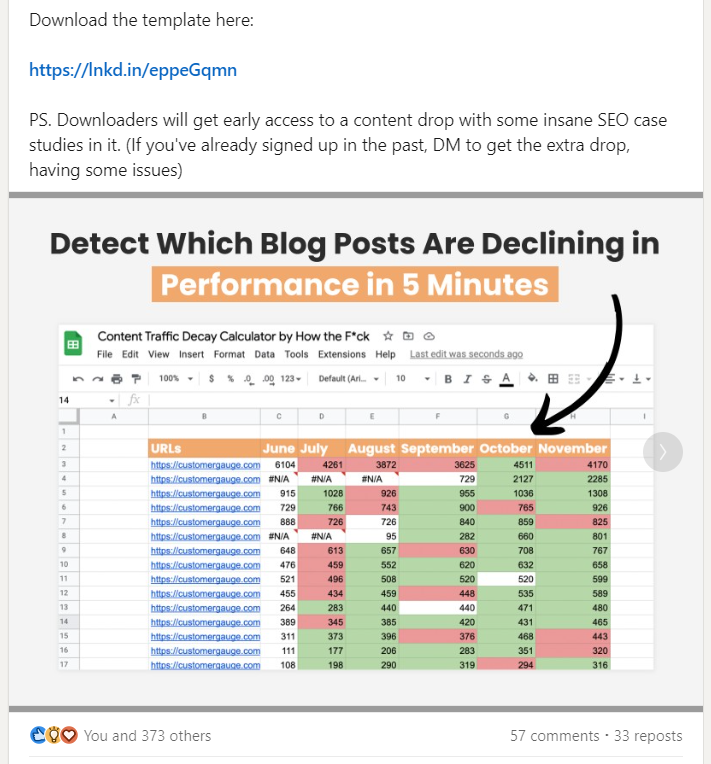
Sam Browne, a Linkedin creator with 56,000 followers grows his list by 1,000 each month using the same method:
- Create high-quality upgrades like eBooks and share them on Linkedin as carousel posts.
- Link to the upgrade as a simple PDF document download for free.
- Ask your audience to share their email address in exchange for the PDF
But remember that you’re not limited to PDFs or LinkedIn only. Sarah Beth lands new subscribers by promoting her free videos on her YouTube channel.

8. Consistently publish quality content that readers value
The most effective form of marketing is word-of-mouth. When someone speaks well of your newsletter to a friend or shares it on social media, you get new sign-ups.
I remember getting a small spike in sign-ups when Katherine McCleery posted about my marketing newsletter on Linkedin.

What drives word-of-mouth is great content.
The newsletter I shared that day did the following things:
- Presented a solution to a real and pressing problem that my readers had.
- Shared bite-sized actionable tips that the reader could implement
- Included examples that allowed the reader to understand and visualize what I was saying.
9. Leave a note at the end of each newsletter asking readers to share it with their friends
When I launched my marketing newsletter, Marketing Cyborg, I added a note at the end of the email asking people to share if they found it useful.
It’s a simple step that takes less than a minute, but even though I had 100 subscribers at the time, I got 3 shares (some of them on social media) and 36 new subscribers from that email.
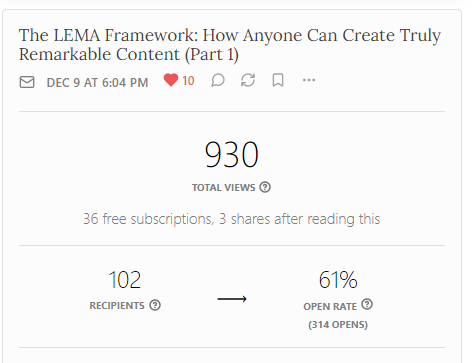
You can even gamify this as Aleyda Solis does with her SEOFOMO newsletter.
I know that I actively referred people to Aleyda’s list to win a reward 😁.
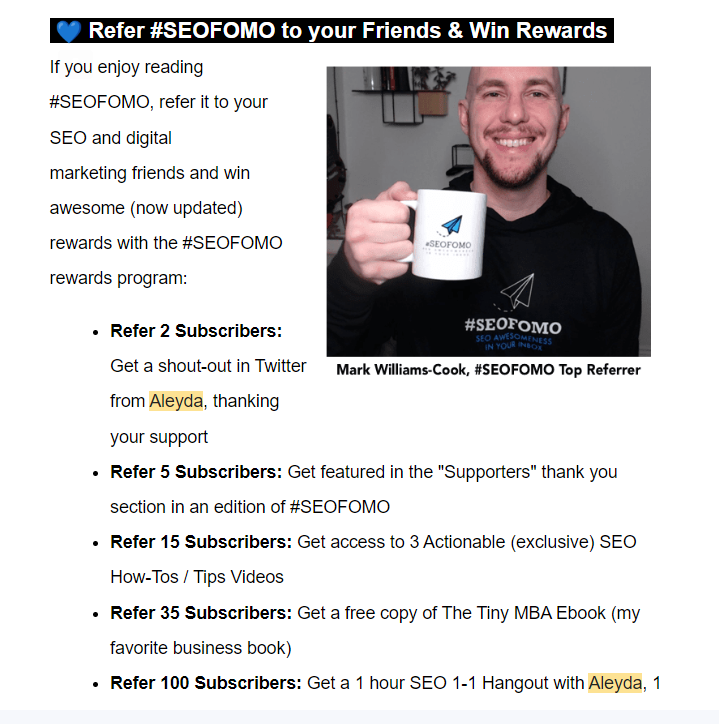
10. Cross-promote your newsletter with other newsletter authors
Even with my small list of fewer than 300 subscribers, I’ve sent four newsletters a total of 131 subscribers just by recommending them.
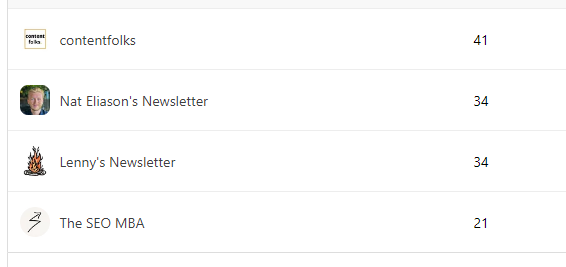
Imagine what collaborating with several newsletter authors can do to your list!
- Find newsletters that are around the same size as yours, up to twice your list size works.
- Send a simple email to the author commending their work.
- Explain what you propose and tell them that you’ll promote their newsletter as well.
- Share your numbers like open rates, list size, and clickthrough rates.
11. Guest on podcasts where you can promote your newsletter
I’ve only published one issue of my newsletter. The largest amount of email signups came on launch day, but the second biggest spike came from going on a podcast.

Find podcasts in your niche with active listeners and pitch them. During your talk, mention some resources related to the topic you’re speaking on, and let the audience know that you’ll leave links to the resources in the show notes.
Tip! I went on a number of big podcasts, but only one sent me any newsletter subscribers. The difference was that podcast had a newsletter, so the listeners were already accustomed to reading emails.
12. Consider leveraging paid advertising
One effective way to attract new subscribers to your newsletter is through targeted advertising.
When you run ads, you can reach people who wouldn’t find you organically. And if they’re interested in your content, you can add new subscribers that way.
If you use WordPress.com Newsletter, try using Blaze to promote your content on sites using Tumblr and WordPress.com at cheaper rates than you’d normally get for display ads.

Start Your Newsletter With WordPress.com
If you’re interested in starting your own newsletter, WordPress.com is a great option.
It offers more flexibility compared to newsletter services like Substack. You can design a newsletter experience that stands out from the other WordPress.com newsletters.
That’s great for branding and memorability. Start your newsletter on WordPress.com for free.
And if you’re looking for the best email plugin for WordPress, MailPoet has you covered..
When you do start your newsletter:
- consider what ‘valuable’ means to your audience
- confirm that your offer conveys ‘value’
- make your offer visible
- and ask for a little help spreading the word
Want more tips? Get new post notifications emailed to you.

